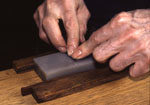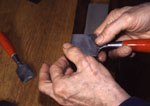

|
|
Table
of contents
|
|
A
Guide to Honing and Sharpening
Removal
of The Burr
Click
on the picture to enlarge
 |
What
we now have is a tool with a burr at the end. The burr is weak but
still attached to the body of the tool. What we want to do is remove
it carefully, leaving a sharp, even edge behind. We remove the wire
edge by continuing to hone both sides. This abrades the areas joining
the burr with the tool. Also, by working both sides of the tool the
motion flexes the burr back and forth weakening it, much like bending
a paperclip back and forth until it breaks. |
 |
A:
Rub back of blade on Arkansas stone. Hold tool perfectly flat. Do
not hold the handle at all; Keep the tool flat on the stone by downward
finger pressure on the the blade alone. THe only exception to this
are unually long or heavy tools which are easier to keep flat on the
stone with a slight assist from below. Rub 10 - 20 circular strokes.
Burr will shift to bevel (front) side. This is called "chasing the
burr." |
 |
Notice
how, while honing the back, the pressure is placed on the front of
the tool, near the edge. Neverless the tool remains flat on its
back and we are not lifting up from the stone at all during this
process. |
 |
Be
careful: if you run the handle of the tool onto the stone you can,
accidently, lift of the flat back off the cutting edge, spoiling its
flatness. |
| |
B:
Rub bevel on Arkansas stone 10 - 20 strokes. This step is exactly
like the previous bevel honing. The wire edge will flip over to the
back. |
 |
Repeat
II A and II B until burr cannot be felt. Putting a finger on a blade
is a time-honored way of checking for the burr, but be careful. These
tools are sharp. Lightly run your finger from the back of the chisel
off the edge. Not the other way around. After you hone the back the
burr should be felt on the bevel side. After you hone the bevel
the burr should be felt on the back side. As you flop back
and forth, honing each side there will be less and less burr to be
felt. Sometimes the burr drops off onto the stone, as a fine silver
wire. When the burr is gone, you are done. Congratulations! |

|
If
the burr does not seem to be moving from back to bevel as you hone,
check the flatness of the back of the tool. A common cause when
you cannot move the burr from the back to the bevel, is that the
back of the tool isn't actually flat and the burr isn't being touched
and abraded by the stone. In the case of waterstones also check
the flatness of your stones.
Note:
Sometimes a back of a tool that was previously flat seems to be
not flat at the very edge. This can happen due to accidentally lifting
the tool during this step or, very possibly, because of heavy use,
the back of the blade, next the edge can actually wear.
|
| |


|
